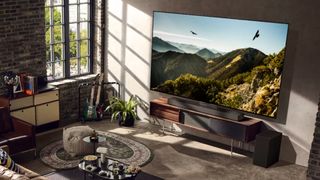
While OLED TVs like the LG C3 OLED and Samsung S95C OLED are some of the best TVs you can buy this year, there’s always a fear that something better will come along.
Thankfully, according to the VP of Universal Display Mike Hack, there’s nothing to worry about — OLED will be the best display technology for at least the next 10 years thanks to innovations like PHOLED and the dry printing (OVJP) of OLED panels.
Speaking with The Elec, Hack said that MicroLED — a strong rival for OLED — looks impressive, but won’t be able to compete in price with OLED.
"It's an interesting technology, but it's going to be very difficult to be competitive against OLED,” Hack says. “MicroLED technology is not ready for commercializing in most products, and I think it will be very difficult for MicroLEDs to be competitive compared to OLEDs at this time."
What does the future look like for OLED TVs?
Admittedly, saying that OLED is the future of display technology is kind of what you’d expect the VP of one of the world’s largest producers of OLED panels to say, but Hack has an inside track into the innovations coming down the pipeline for OLED panels and can speak with some authority on the display type’s future.
The innovations that Hack seems the most excited about are PHOLED and dry printing. The former trades the fluorescent blue subpixels out for phosphorescent ones. Phosphorescent subpixels are more energy efficient, and could therefore be the key to brighter picture quality and longer shelf life for the TV.
Dry printing, on the other hand, is a new way to manufacture OLED panels that produces less waste. Less waste is both great for the environment and great for your wallet because OLED manufacturers have to factor in the cost of the wasted materials when selling a panel to LG or Samsung.
Sign up to get the BEST of Tom’s Guide direct to your inbox.
Upgrade your life with a daily dose of the biggest tech news, lifestyle hacks and our curated analysis. Be the first to know about cutting-edge gadgets and the hottest deals.
Lower prices are key to OLED staying on top of the display world. One of the big problems that MicroLED has is that it’s still incredibly expensive to produce — which means that MicroLED TVs like Samsung’s The Wall are substantially more expensive than similarly sized OLED TVs from LG, even as OLED expands into even bigger sizes.
In short, MicroLED is an exciting technology — but not one you have to worry about supplanting your brand-new OLED TV anytime soon.
More from Tom's Guide

Nick Pino heads up the TV and AV verticals at Tom's Guide and covers everything from OLED TVs to the latest wireless headphones. He was formerly the Senior Editor, TV and AV at TechRadar (Tom's Guide's sister site) and has previously written for GamesRadar, Official Xbox Magazine, PC Gamer and other outlets over the last decade. Not sure which TV you should buy? Drop him an email or tweet him on Twitter and he can help you out.
-
Keng Yuan Well, but please update the pixel structure too, RGB for a full square pixel please, like JOLEDReply
